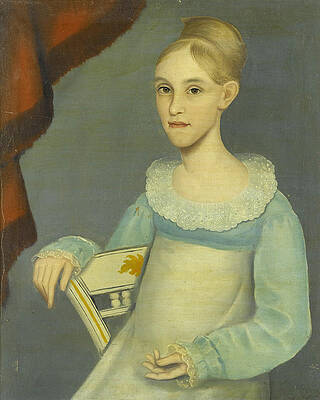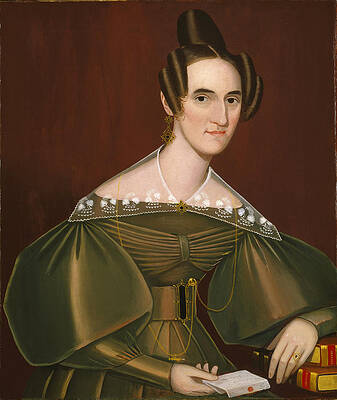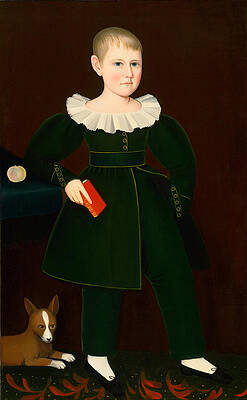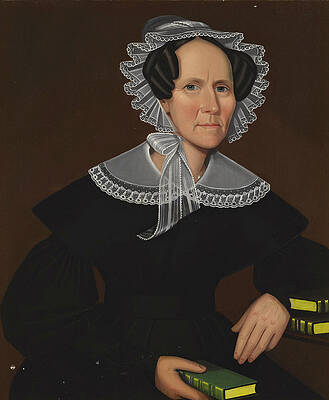Ammi Phillips
Paintings
Portrait of a Winsome Young Girl in Red with Green Slippers Dog and Bird
Jeannette Woolley later Mrs. John Vincent Storm
Henrietta Dorr
Blond Boy with Primer Peach and Dog
Portrait of a Rosy Cheeked Young Girl in a Pink Dress
Portait of a Young Boy in Plaid with Dog
Mary Elizabeth Smith
Mrs Mayer and Daughter
Catherine A. May
Mrs. Reuben Allerton. Lois Atherton
Woman seated on a red sofa
Joseph Slade
Alsa Slade
Cornelius Allerton
Portrait of Elizabeth Mygans
Portrait of Mrs. Robinson
Portrait of a Woman holding a Book

Fine Art Prints | Greeting Cards | Phone Cases | Lifestyle | Face Masks | Men's , Women' Apparel | Home Decor | jigsaw puzzles | Notebooks | Tapestries | ...
Ammi Phillips (April 24, 1788 – July 11, 1865) was an American itinerant portrait painter active in Connecticut, Massachusetts, and New York for five decades. After his death he was forgotten for decades until his oeuvre was reconstructed by Barbara and Larry Holdridge, collectors and students of American folk art, with the eventual support of Mary Black, art historian, after many friendly arguments and challenges to prove their contention that Phillips was not only the Kent Limner but also the earlier Border Limner. The Holdridges' extensive search in three states for Phillips paintings and for biographical details to be found in the Census Bureau and other written records, as well as the fading memories of still-living relatives of the artist and his portrait subjects (from one of whom they learned the pronunciation of the artist's first name, "Amm-eye") was triggered by their purchase in 1958 of one of the very few portraits signed on the reverse by the artist: "George C. Sunderland Painted When at the Age of 21 years by Mr, Ammi, Phillips, In the fall 1840."[1]
Career
Phillips was born in Colebrook, Connecticut on April 24, 1788, beginning a life that spanned the period from the beginning of George Washington's presidency to the end of the American Civil War. His extensive, continuously evolving oeuvre over a period of five decades provides posterity with a vast archive of early American self-fashioning.
While his early education remains obscure to history (although Phillips is often considered a self-taught artist, he may have apprenticed with another artist)[2] it's clear that Phillips made up his mind to pursue a career as an artist while still young. He enters the documentary record as an artist in 1809, at the age of 21, with advertisements in both The Berkshire Reporter[3] and a Pittsfield, Massachusetts tavern[4] proclaiming his talent for painting "correct likenesses," distinguished by “perfect shadows and elegantly dressed in the prevailing fashions of the day.” Although Phillips also advertised his talent for "fancy painting, silhouettes, sign and ornamental painting,"[3] he soon specialized as a portraitist. His work satisfied the local standard, and within two years Phillips was receiving regular portrait commissions from community leaders in this area of western Massachusetts.[3]
Unlike Phillips' illustrious predecessors in American art, such as Benjamin West of Philadelphia and John Singleton Copley of Boston, Phillips lived and worked on the rural frontier—a difference which is key to understanding his career. Though he was able to successfully market his skills from a young age, it's likely that the relatively sparse demand for painted portraits (a luxury good that reflects and signals a certain social standing) outside the capitals was the main factor necessitating an itinerant career that saw the artist move regularly, family perhaps in tow, between western Massachusetts, Connecticut, and the Hudson River Valley. The artist moved on as he exhausted the demand of the local community for painted "likenesses". This wandering lifestyle is archetypically Romantic, rather contrasting with the bourgeois domesticity of his portraits, which are almost always set within interiors. A letter from the American artist John Vanderlyn to his nephew, John Vanderlyn, Jr., from Kingston, New York, dated September 9, 1825, stated, "Were I to begin life again, I should not hesitate to follow this plan, that is, to paint portraits cheap and slight, for the mass of folks can't judge of the merits of a well finished picture, I am more and more persuaded of this. Indeed, moving about through the country as Phillips did and probably still does, must be an agreeable way of passing ones time. I saw four of his works at Jacobus Hardenburgh's the other day painted a year or two ago, which seemed to satisfy them."[5]
We may contrast this somewhat supercilious opinion of Phillips' artistic worth with the conclusion of the twentieth-century art critic Hilton Kramer, who wrote in The New York Times in 1970, "In the Plain and Fancy exhibition, for example, there are five portraits by the amazing Ammi Phillips (1788–1865), and at least two of them—the portraits of Mrs. Isaac Cox and of Deacon Benjamin Benedict (both about 1836)—are of superb quality. To the modern eye, the portrait of Mrs. Cox particularly speaks with a clarity, precision, and sympathy that places it considerably nearer to our own standards of artistic probity than anything to be found in the common run of 'serious' painting at the time. If this is 'innocent' painting, it is innocent only of those flatulent academic pretensions which remained the curse of so much of our art in the 19th century."
Phillips may actually have learned some of his skills from the portraits by John Vanderlyn he saw hanging in the homes of his wealthy patrons. Some aspects of Phillips' works are reminiscent of Vanderlyn's.
Ammi Phillips lived into the era of the daguerreotype, and his last portraits show this influence He died on July 15, 1865, age 72, in Curtisville, Massachusetts, just outside Stockbridge, where his death certificate is filed in the Town Hall. He was buried in Amenia, New York, where he had lived earlier in his life.
Girl in Red Dress with Cat and Dog
The artist's most famous work is Girl in Red Dress with Cat and Dog, which is in the collection of the American Folk Art Museum in New York. The painting is one of a group of four portraits of children in vibrant red with a dog on the floor that Phillips produced while living in Dutchess County, New York, in the mid-1830s.[4] This iconic work is the only one that features a cat.
The image is frequently reproduced and admired. It was featured on a United States postage stamp in 1998. Nicholas B.A. Nicholson wrote a novel told from the perspective of the depicted girl.[6]
Ken Johnson, an art critic for The New York Times, has repeatedly praised the picture. In a review of the American Folk Art Museum's exhibition Self-Taught Genius, Johnson contends that Girl in Red Dress with Cat and Dog is "one of the most beautiful paintings made by any American artist ever."[7] Previously he described the work as "heartbreakingly lovely."[8]
The novelist and art historian Teju Cole, in the third chapter of his debut novel Open City, describes a visit to the American Folk Art Museum. The narrator notices and evaluates Girl in Red Dress with Cat and Dog: "At the landing of the first flight of stairs, I saw an oil portrait of a young girl in a starchy red dress holding a white cat. A dog peeked out from under her chair. The details were saccharine, but they could not obscure the force and beauty of the painting."[9]
Rediscovery of the artist and reconstruction of his oeuvre
Phillips' modern rediscovery began in 1924, when a group of portraits of women, shown leaning forward in three-quarter view and wearing dark dresses, were displayed in an antique show in Kent, Connecticut. The anonymous painter of these strongly colored works, which dated from the 1830s, became known as the "Kent Limner", after the locality where they had come to light.[10]
Stylistically distinct from those of the "Kent Limner", a second group of early-19th-century paintings emerged after 1940 in the area near the Connecticut–New York border. Attributed at the time to an unknown "Border Limner", these works, dating from the period 1812–1819, were characterized by soft pastel hues and limited drawing skills, as seen in the portraits of Mrs. Russell Dorr and Baby, now in the Abby Aldrich Rockefeller Folk Art Collection, Williamsburg, Virginia, and of Harriet Leavens, now in the Fogg Art Museum, Harvard University.[11]
It was not until 1958 that Ammi Phillips' identity as the painter of both groups of portraits was established by Barbara and Larry Holdridge, and endorsed by Mary Black, writing on May 21, 1959 to three fellow folk-art historians, "You are the ones who should be the first to know that I have joined the opposition [i.e., the Holdridges] and now believe that the Border Limner, Ammi Phillips, A. Phillips, and the Kent Limner are one and the same person." Additional works were identified, showing the artist's transition from the delicate coloration of the Border period to the bold and dramatic works that followed. Some paintings that had previously been attributed to John Bradley were also identified as the work of Ammi Phillips.[12] By 1976, there were approximately 400 paintings securely attributed to Phillips, who is now recognized as one of the most prolific American folk painters of his time.[10] Scores more have been discovered since then.
The art historian Mary Black said Phillips' early and late styles reveal the untrained artist's inventiveness in dealing with the difficulty of representing the figure: "In his Border period he made his limitations work for him and the lumpy coats, gangling limbs, huge hands, wooden arms—even the tables tilted at crazy angles—were all part of well-composed and beautiful portraits. Later he glossed over problems with anatomy by using flat dark-colored backgrounds and dark dresses and suits".[10] Phillips' work influenced the style of his younger contemporary, Erastus Salisbury Field, who worked as an itinerant portrait painter in the region just east of Phillips.[10]
The Museum of American Folk Art showed its first major exhibition devoted to the work of a single folk portraitist to "Ammi Phillips, Portrait Painter 1788–1865," on exhibit from October 16 to December 2, 1968. There have been numerous notable exhibits since then.
Notes
Barbara and Larry Holdridge, "Ammi Phillips," Art in America, Summer 1960, p. 99.
Black, Mary (intro). Ammi Phillips: Portrait Painter 1788-1865. Clarkson N. Potter, Inc., New York: 1981. p. 10.
Hollander, Stacy C. (Spring 1994). "Revisiting Ammi Phillips". Folk Art. 42–45. Retrieved June 16, 2014.
folkartmuseum.org. Retrieved June 16, 2014.
Black and Holdridge 1969, p. 14.
goodreads.com. Retrieved June 16, 2014.
http://www.nytimes.com/2014/05/23/arts/design/inspiration-made-concrete-in-self-taught-genius-exhibition.html
http://www.nytimes.com/2008/10/27/arts/design/27ligh.html?pagewanted=print
Cole, Teju. Open City. New York: Random House Trade Paperbacks, 2012. P. 36.
Black 1976.
Mills, Sally. "Phillips, Ammi." Grove Art Online. Oxford Art Online. Oxford University Press. Retrieved June 2, 2014.
Black, Mary C.; Stuart H. Feld (October 1966). "'Drawn by I. Bradley from Great Britton'". Antiques 90: 501–509.
References
Black, Mary, Barbara C. and Lawrence B. Holdridge. "Ammi Phillips: Portrait Painter 1788–1865". New York: Clarkson N. Potter, 1969.
Black, Mary. "The Search for Ammi Phillips," ARTnews, April 1976: 86–89.
Black, Mary. "Ammi Phillips: The Country Painter’s Method", The Clarion, Winter 1986.
Hollander, Stacy C. American Radiance: The Ralph Esmerian Gift to the American Folk Art Museum. New York: American Folk Art Museum in association with Harry N. Abrams, Inc., 2001.
Bulkeley, Morgan, "An Artist Arises". The Berkshire Eagle, January 13, 1966.
Holdridge, Barbara and Larry. "Found: A Berkshire Old Master". Berkshire Week, August 30–Sept. 5, 1959, 10-
Holdridge, Barbara and Larry. "Ammi Phillips: Limner Extraordinary," Antiques, December 1961.
Holdridge, Barbara and Larry. "Ammi Phillips," Art in America, Summer 1960: 98–103.
Hollander, Stacy C. The Seduction of Light: Ammi Phillips | Mark Rothko Compositions in Pink, Green, and Red. New York: American Folk Art Museum, 2008.
Hollander, Stacy C., and Brooke Davis Anderson. American Anthem: Masterworks from the American Folk Art Museum. New York: American Folk Art Museum in association with Harry N. Abrams, Inc., 2001.
Hollander, Stacy C., and Howard P. Fertig. Revisiting Ammi Phillips: Fifty Years of American Portraiture. New York: American Folk Art Museum, 1994.
History of Art: Ammi Phillips - all-art.org
Kramer, Hilton. "Recovering the American Past", The New York Times, Sunday, May 10, 1970.
Mills, Sally. "Phillips, Ammi". Grove Art Online. Oxford Art Online. Oxford University Press. Retrieved June 2, 2014.
----
Fine Art Prints | Greeting Cards | Phone Cases | Lifestyle | Face Masks | Men's , Women' Apparel | Home Decor | jigsaw puzzles | Notebooks | Tapestries | ...
----
Artist
A - B - C - D - E - F - G - H - I - J - K - L - M -
N - O - P - Q - R - S - T - U - V - W - X - Y - Z
Retrieved from "http://en.wikipedia.org/"
All text is available under the terms of the GNU Free Documentation License




















